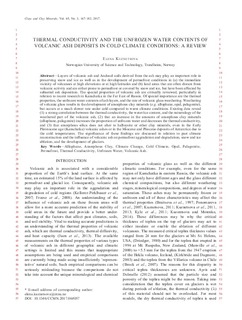| dc.description.abstract | Layers of volcanic ash and Andosol soils derived from the ash may play an important role in preserving snow and ice as well as in the development of permafrost conditions in (a) the immediate vicinity of volcanoes at high elevations or at high latitudes and (b) land areas that are often distant from volcanic activity and are either prone to permafrost or covered by snow and ice, but have been affected by subaerial ash deposition. The special properties of volcanic ash are critically reviewed, particularly in relation to recent research in Kamchatka in the Far East of Russia. Of special importance are the thermal properties, the unfrozen water contents of ash layers, and the rate of volcanic glass weathering.Weathering of volcanic glass results in the development of amorphous clay minerals (e.g. allophane, opal, palagonite), but occurs at a much slower rate under cold compared to warm climate conditions. Existing data reveal (1) a strong correlation between the thermal conductivity, the water/ice content, and the mineralogy of the weathered part of the volcanic ash, (2) that an increase in the amounts of amorphous clay minerals (allophane, palagonite) increases the proportion of unfrozen water and decreases the thermal conductivity, and (3) that amorphous silica does not alter to halloysite or other clay minerals, even in the Early Pleistocene age (Kamchatka) volcanic ashes or in the Miocene and Pliocene deposits of Antarctica due to the cold temperatures. The significance of these findings are discussed in relation to past climate reconstruction and the influence of volcanic ash on permafrost aggradation and degradation, snow and ice ablation, and the development of glaciers. | nb_NO |
